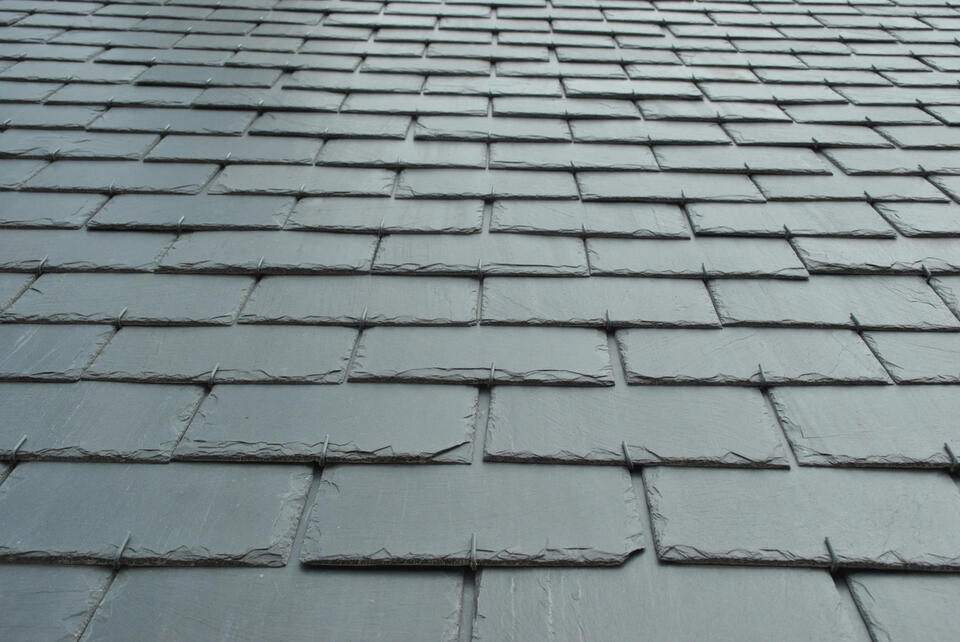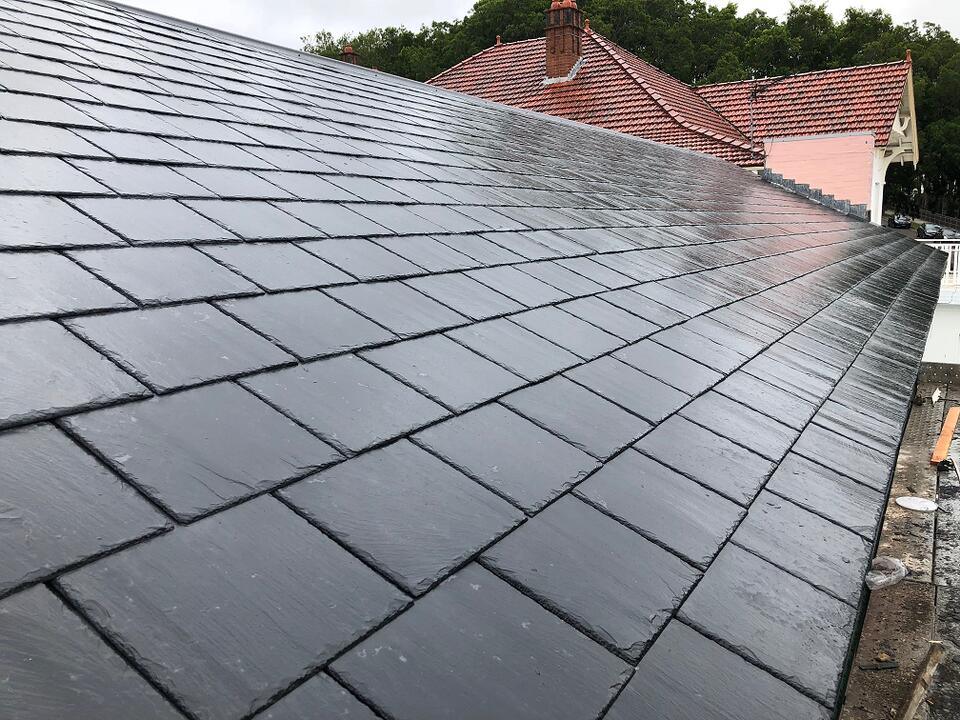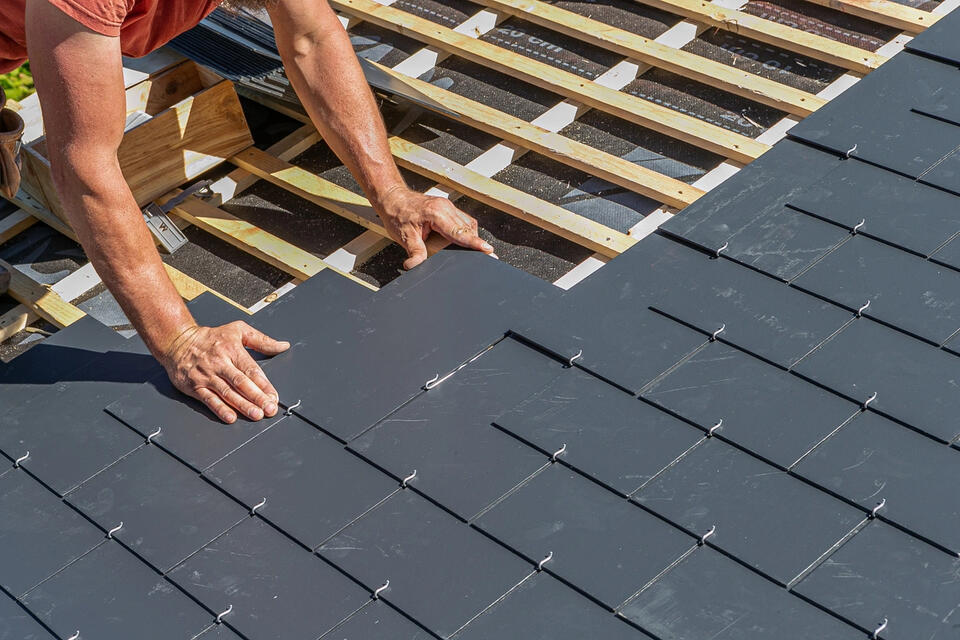Rubber Slate Roofing: Pros & Cons
In recent years, homeowners have been increasingly drawn to rubber slate roofing as a viable alternative to traditional roofing materials. The appeal of rubber slate lies in its combination of durability, cost-effectiveness, and environmental benefits. As people become more environmentally conscious and seek sustainable solutions, these factors make rubber slate an attractive option. By mimicking the aesthetic of natural slate while offering enhanced resilience against weather-induced wear and tear, rubber slate provides not only a robust but also a visually appealing solution. If you love the look of slate but want a less expensive alternative for your roof replacement in Omaha, consider the pros and cons of rubber slate roofing. These are brought to you by Shamrock Roofing and Construction, one of the area’s leading roofing companies. Here, we’ll share everything you need to know about rubber slate roofing help you make the best decision for your home upgrades, including:
- What is rubber slate roofing?
- 4 pros of rubber slate roofing
- 4 cons of rubber slate roofing
- Comparing rubber slate roofing to other roofing materials
🤔 What is Rubber Slate Roofing?

Rubber slate roofing is a type of roofing material made from recycled rubber, designed to mimic the appearance of traditional slate. This innovative product combines the aesthetic appeal of natural slate with the durability and lightweight properties of rubber.
Key features of rubber slate roofing include:
- Closely resembles traditional slate for an elegant look
- Lightweight and flexible, making installation easier
- Resistant to weathering for long-lasting performance
- Eco-friendly option made from recycled materials
Unlike natural slate, which can be prone to cracking and requires careful installation, rubber slate is more flexible and easier to work with. It offers homeowners a beautiful and functional roofing solution.
✅ 4 Pros of Rubber Slate Roofing

Rubber slate roofing offers significant advantages, including durability and low maintenance, making it an essential choice for homeowners looking for long-lasting protection. Its eco-friendly nature and energy efficiency further enhance its importance in sustainable building practices.
1. Durability
While less money and shorter installation time give rubber slate a significant boost in the minds of consumers (not to mention your roofing contractor in Omaha), this roofing material has even more benefits. Rubber roofs are incredibly durable and resilient, outlasting asphalt by a significant margin. Rubber slate roofing boasts a life expectancy of approximately 50 years if well maintained. It also comes with a Class 4 impact rating, meaning it’ll stand up to Midwest hail storms, ice, and snow with no problem. These features are highly appealing to Omaha residents who know that extreme weather conditions can be an issue throughout the year.
2. Cost-Effectiveness
One of the most significant and consumer-friendly “pros” of slate’s rubber alternative is its reduced cost. Depending on the manufacturer, rubber slate runs anywhere from $7.00 to $12.00 per square foot, while natural slate averages around $13.00 per square foot — and that’s on the lower end of the pricing spectrum! Additionally, slate’s rubber doppelganger is easy to install and can be done quickly for homeowners in a pinch. It’s the perfect solution for a roof replacement resulting from storm damage or renovations during a buy-and-flip situation.
3. Eco-Friendliness
Rubber slate is crafted from recycled materials, making it a sustainable and eco-conscious choice for roofing. By choosing rubber slate, homeowners not only support the recycling industry but also play a vital role in reducing waste. This roofing option minimizes the need for new raw materials, thus conserving natural resources. Furthermore, using recycled materials helps lower the carbon footprint associated with traditional roofing materials. As global awareness of environmental issues grows, opting for eco-friendly solutions like rubber slate demonstrates a commitment to sustainability and can even enhance the home’s value.
4. Ease of Installation
One significant advantage of rubber slate roofing is its lightweight nature, which simplifies the installation process. This lightweight characteristic means that less structural reinforcement is often required, saving homeowners both time and money. The quicker installation leads to reduced labor costs and minimizes disruption during the roofing project. Additionally, rubber slate is compatible with various roof structures, including sloped, flat, and low-slope roofs, making it a versatile choice for a wide range of residential designs. Its ease of handling and flexibility also allows for creative architectural applications, ensuring that homeowners can achieve the aesthetic they desire without sacrificing performance.
🚫 4 Cons of Rubber Slate Roofing
While rubber slate roofing offers several advantages, there are some drawbacks to consider:
1. Aesthetic Limitations
Rubber slate may not perfectly replicate the natural beauty of real slate tiles. While it can mimic the texture and shape, many homeowners find that the color variations and natural imperfections of genuine slate are difficult to achieve with rubber. Over time, the roofing material can fade due to exposure to UV rays, weather elements, and pollutants, which can significantly impact the roof’s overall aesthetic appeal. This fading may lead to an uneven appearance, prompting some homeowners to seek replacements sooner than expected.
2. Limited Availability
Rubber slate roofing is not as widely available as traditional roofing materials like asphalt shingles or metal roofing. This limited availability can make it more challenging for homeowners to find suppliers and installers who are experienced with rubber slate. As a result, homeowners may need to invest extra time in researching and locating qualified professionals, which can delay installation and increase costs. Additionally, some regions may have restrictions or limited options for sourcing rubber slate, affecting overall accessibility.
3. Potential for Surface Damage
Although rubber slate is designed to be durable, it can be prone to staining and superficial damage from debris, tree sap, or other environmental factors. Without regular maintenance, such as cleaning and inspections, these stains can become more pronounced, detracting from the roof’s visual appeal. Homeowners must be proactive in caring for their rubber slate roofs, which may include scheduled cleanings and repairs. This ongoing maintenance is an important factor to consider for those who prefer low-maintenance options.
4. Unpleasant Odor
Some rubber slate products may emit an unpleasant odor, particularly when exposed to heat or direct sunlight. This smell can be more pronounced in warmer climates or during the summer months, leading to discomfort for homeowners and potential irritations for those sensitive to odors. While many manufacturers aim to minimize these odors through improved formulations, it’s still a consideration for prospective buyers. Homeowners should be aware of this potential issue and evaluate the specific product’s reviews and characteristics before making a decision.
👉 Comparing Rubber Slate to Other Roofing Options

Analyzing how rubber slate stacks up against other popular roofing materials such as asphalt shingles, metal roofing, or traditional slate can provide invaluable insights for decision-makers. By highlighting key differences in durability, cost, aesthetic appeal, and maintenance requirements, readers can gain a comprehensive understanding of rubber slate’s position within the broader roofing landscape. Here are some detailed comparisons:
Durability
- Rubber Slate: Highly resistant to extreme weather conditions, including high winds, hail, and heavy rain. Can last 50+ years with proper care.
- Asphalt Shingles: Typically last 15-30 years; susceptible to damage from high winds and extreme temperatures.
- Metal Roofing: Extremely durable, lasting 40-70 years, and can withstand harsh weather; however, it may dent from hail.
- Traditional Slate: Very durable, can last over 100 years, but is heavy and susceptible to cracking.
Cost
- Rubber Slate: Mid-range cost; installation can be more expensive initially, but longevity may offset this.
- Asphalt Shingles: Generally the most affordable option upfront, but replacement costs add up over time.
- Metal Roofing: Higher initial cost, but energy-efficient and long-lasting; often pays off in the long run.
- Traditional Slate: High initial cost; heavy and requires reinforced roofing structures.
Aesthetic Appeal
- Rubber Slate: Available in various colors and styles, simulating the look of traditional slate without the weight.
- Asphalt Shingles: Offers a wide range of colors and styles but can appear less upscale than other materials.
- Metal Roofing: Comes in various colors and finishes; can be less traditional in appearance, which may not fit all homes.
- Traditional Slate: Timeless elegance and natural beauty; adds significant value to a home, but installation can be challenging.
Maintenance Requirements
- Rubber Slate: Low maintenance; resistant to algae and moss growth, but regular inspections are recommended.
- Asphalt Shingles: Requires periodic inspections and maintenance to prevent leaks and shingle lift.
- Metal Roofing: Low maintenance, but requires occasional cleaning to prevent rust and ensure longevity.
- Traditional Slate: High maintenance; requires inspections and repairs on cracked tiles to prevent leaks.
By considering these factors, homeowners and decision-makers can make a more informed choice about roofing materials, ensuring they select the best option for their needs and preferences.
🙌 The Importance of Choosing the Right Installation Team for Rubber Slate Roofing
While rubber slate roofing offers a balance of durability, aesthetics, and cost that appeals to many homeowners, choosing the right installation team is crucial. At Shamrock Roofing and Construction, our dedication to quality service and expert craftsmanship ensures that your roofing project is in the best hands. With extensive experience and deep knowledge of rubber slate and other materials, our team assists you in making an informed decision for your home. Ready to explore the benefits of rubber slate roofing with trusted professionals? Contact Shamrock Roofing and Construction today for a consultation, and let us provide the exceptional service and peace of mind you deserve.
